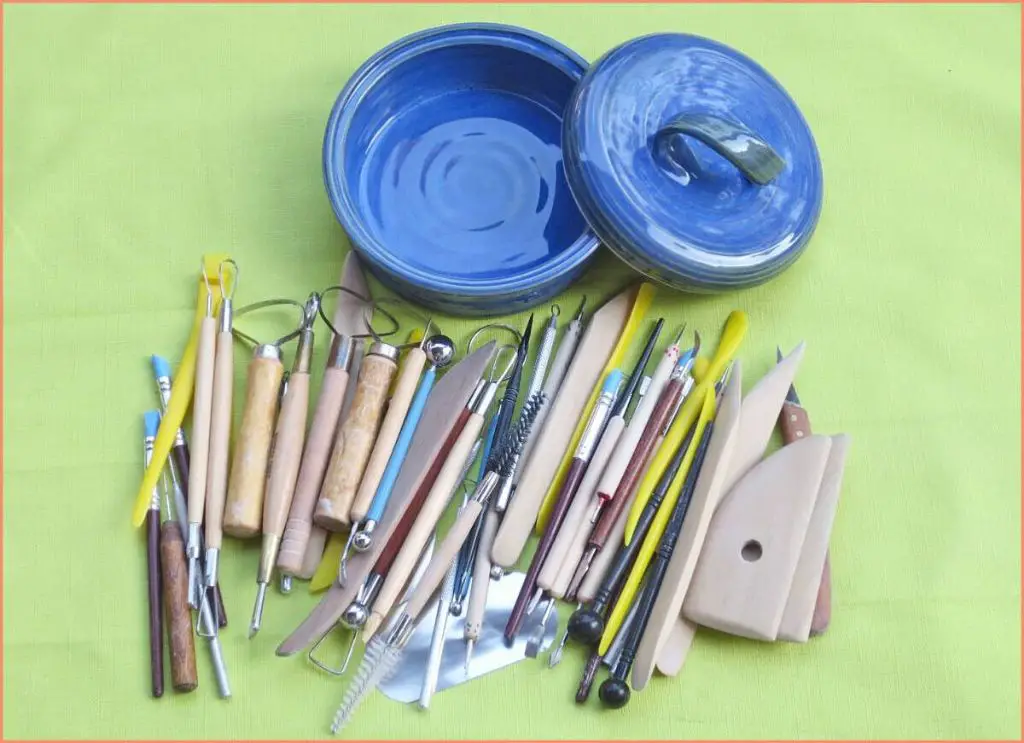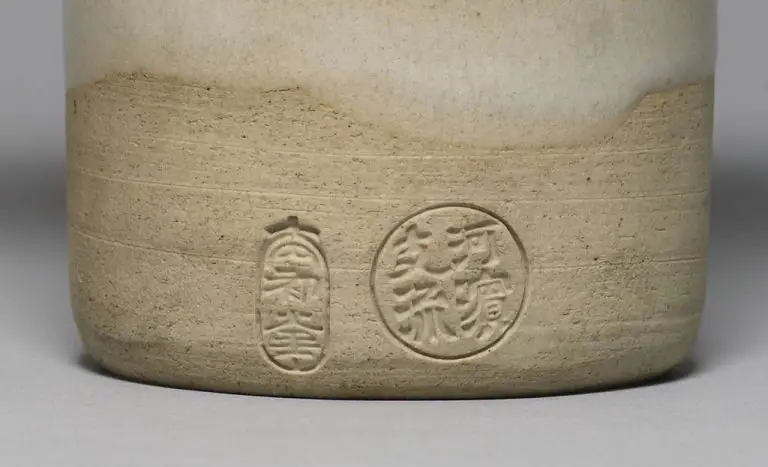What Are Ceramics Tools Called?
Ceramics are inorganic, non-metallic materials that are hardened when heated to high temperatures. They are made from clay, silicates, and other natural substances.
Ceramic tools refer to the various equipment used in the creation and decoration of ceramic wares. Potters utilize a wide range of implements throughout the ceramic making process, from mixing and preparing clay to throwing, handbuilding, glazing, and firing.
Some of the most common ceramic tools include pottery wheels, kilns, clay extruders, ribs, loop tools, trimming tools, brushes, sponges, sculpting tools, and more. Ceramic artists use these specialized tools to shape, decorate, finish, and fire their clay pieces.
Overall, ceramic tools allow potters and ceramicists to expertly craft both functional and decorative works in clay. The variety of implements reflects the diverse techniques and processes involved in working with this unique medium.
Pottery Wheels
Pottery wheels are used to shape clay into symmetrical forms and vessels by rotating the clay as the potter shapes it with their hands. They allow potters to efficiently create uniform pieces with thinner walls and smoother surfaces compared to handbuilding techniques.
There are several main types of pottery wheels:
- Kick wheels – The potter turns the wheel by foot power using a kick wheel or treadle. These are simple, inexpensive wheels that can be operated without electricity.
- Electric wheels – Powered by an electric motor, these offer variable speed control and don’t require leg power to operate. They allow for more precise control.
- Spring wheels – An old-fashioned design powered by wound springs. They provide momentum but don’t allow for speed control.
Pottery wheels use the centrifugal force created by the spinning wheel head to shape and center the clay. The wheel head, bat, or work surface rotates while the potter uses their hands to shape the clay, guiding the walls up and outward. Water is used as lubrication. As the potter’s hands press inward and upward, centripetal force works to compress the clay particles together, thinning the walls.
Pottery wheels originated over 4,000 years ago in Mesopotamia and ancient Egypt before spreading to many cultures worldwide. Their invention revolutionized pottery production and enabled more uniformity and efficiency.
Modern electric wheels like the ones made by Brand allow for precise speed control and ergonomic designs for user comfort during long throwing sessions.
Kilns
A kiln is an important tool for ceramic artists and potters. Its purpose is to heat ceramics to high temperatures in order to permanently harden clay objects, fuse glazes to clay, fire enamel or lusters, and perform other processes. There are several main types of kilns used for pottery.
One common type is the electric kiln, which uses heating elements powered by electricity to heat the interior chamber. Electric kilns allow for precise temperature control. Another major type is the gas kiln, which uses propane or natural gas burners to fire ceramics. Gas kilns can reach higher temperatures and offer effects like atmospheric firing. Additional types include wood-fired kilns, raku kilns, and pit/saggar firing kilns. Each provides unique design, fuel source, and firing characteristics.[1]
Key parts of a kiln include the firebrick chamber that retains and distributes heat, heating elements or burners, peepholes for monitoring the firing, shelves to hold pieces, and the outer insulating kiln housing. During firing, the kiln is slowly heated according to a schedule up to a target temperature, held there to complete processes, then cooled gradually. Kilns allow potters to fully mature and finish their pottery.
Handbuilding Tools
Handbuilding tools are essential for sculpting, shaping, smoothing, and detailing clay pieces made by hand rather than on a wheel. Some of the most common handbuilding tools include:

- Ribbers – Ribbers have a rounded edge on one side and a flat edge on the other, useful for smoothing clay and removing excess material. Ribbers come in various shapes and sizes. Tools
- Loop tools – Loop tools have a wire loop on the end and help shape concave areas of clay sculpture. The loops come in different sizes and profiles.
- Cutters – Clay cutters with flat blades make clean cuts through clay slabs and can trim away excess material. Clay wire cutters create textured lines. Sculpting
These handbuilding tools give the artist precise control for smoothing, carving, cutting, and detailing their clay creations.
Glazing Tools
Glazing tools are an essential part of working with ceramics, as they allow the ceramicist to apply colored glazes and other surface treatments to bisqueware. The most common glazing tools include:
Brushes – Glazing brushes come in a variety of shapes and sizes for different purposes. Larger brushes are useful for quickly covering large areas, while smaller brushes allow for detail work. Glazing brushes are typically made with synthetic bristles. It’s important to keep them clean and stored properly to maintain their shape.
Sprayers – Glaze sprayers atomize the glaze into a fine mist that can be applied evenly across a surface. Handheld pump sprayers are inexpensive and good for small projects. Airbrush sprayers allow for precise glaze application but require an air compressor. Spraying is a fast way to achieve full coverage.
Dippers – Glaze dippers consist of a handle attached to a mesh basket or perforated cylinder. The bisqueware is dipped into a bucket of glaze using the dipper. The holes ensure even glaze application as excess glaze drips back into the bucket. This technique is ideal for smooth, all-over coverage.
Wax resist tools – Wax resist tools allow ceramic artists to selectively apply glaze. A wax resist is painted onto areas where glaze application is not desired. The glaze won’t adhere to waxed areas. Common wax resist tools include wax pencils, wax daubers, wax applicator bottles, and tjanting tools.
Proper tools allow ceramic artists full creative control when applying glazes. With a variety of brushes, sprayers, dippers, and wax resist tools available, artists can achieve their desired decorative effects.
Sources:
https://www.amazon.com/EXCEART-Sculpture-Pottery-Supplies-Dripping/dp/B0BRYLTRLD
Decorating Tools
Many decorating tools are used on ceramic surfaces to add patterns, texture, and color. Some key decorating tools for ceramics work include sponges, stampers, rollers, and extruders (Ceramic Decorating Tools).
Sponges can be cut into different shapes and used to dab glazes or underglazes onto bisqueware to create subtle textures and effects. Sea sponges, cosmetic sponges, and kitchen sponges are popular options. Sponges can create mottled, streaky, or stippled patterns depending on the technique used.
Stamps made of rubber, wood, or bisque are pressed into clay or onto glazed surfaces to imprint instant designs. Geometric patterns, symbols, letters, and complex scenes can all be stamped. Rollers with textured surfaces likewise are rolled over clay or glaze to leave continuous imprints and markings.
Extruders force clay through dies to create long strands, ropes, slabs, or hollow tubes in the die’s shape. Extruded clay can make regular stripes, dots, waves, ripples, and more for covering pottery forms. Extruders allow efficient, consistent, and intricate surface decoration.
Measuring Tools
Measuring tools are essential for potters and ceramic artists to precisely size and shape their pieces. Some key measuring tools include:
Rulers – Rulers made of metal or plastic allow potters to measure the length, width, and diameter of pieces in progress. Steel rulers are very durable for the studio. Rulers with both metric and imperial units help when measuring clay slabs for handbuilding.
Gauges – Slip gauges, cloth thickness gauges, and circle gauges help measure clay thickness and shape rounded pieces to precision. These tools are especially useful when aiming for uniformity across a set of ceramic works.
Calipers – Calipers enable very precise inside, outside, and depth measurements. Dial calipers and digital calipers provide the most accuracy. Caldwell calipers are a top choice for measuring wet clay. Calipers assist with proportion, indexing clay pieces, and achieving symmetry. (Ceramic Measuring Tools).
Profiling Tools – Profiling tools and contour gauges allow potters to precisely record the shape of an object in clay. These tools transfer and reproduce the exact contour needed for lids, joining pieces, asymmetrical forms, and more. Templates can also be made from profiles.
Mixing and Preparation Tools
Proper mixing and preparation of clay is an important first step in working with ceramics. Some key tools used in this process are pug mills, slab rollers, and clay mixers.
Pug mills are used to mix and homogenize clay. They consist of a chamber with a rotating shaft and blades that continuously cut and fold the clay to remove air pockets. Pug mills extrude the clay out in a continuous strip or “pug” ready for use.
Slab rollers are powered rolling pins used to roll out clay into flat, even slabs. They allow potters to quickly roll uniform slabs for handbuilding and other techniques. Different thicknesses can be achieved by adjusting the slab roller’s rollers.
Clay mixers and blungers are used to initially mix up dry clay powder with water to make potter’s clay or slip. They blend the clay and water into a smooth, homogeneous mixture ready for further processing or use. Industrial blungers can mix hundreds of pounds of clay at once.
Proper use of these mixing and preparation tools allows potters to efficiently process clay into the desired condition and consistency for their projects. They are indispensable items found in most pottery studios.
Modeling Tools
Modeling tools are used to shape, refine, and modify clay pieces while working on the potter’s wheel or handbuilding. Some common types of modeling tools include:
Needle tools – These are thin, pointed metal tools used to refine details and add texture. They come in various sizes and can be used for scraping, carving, incising lines, and making holes.1Pcs/lot Stainless Steel DIY Pin Ceramic Clay Sculpture Tools are a common set of needle tools for ceramic work.
Ribs – These are rigid, blunt tools made of wood, metal or plastic used to smooth and shape clay. Metal ribs can scrape and cut clay while wooden ribs compress and smooth. Ribs help compress clay coils and slabs.
Loop tools – These metal tools have a variety of shaped wire or rod ends such as round, square or teardrop shaped. They are used to refine shapes, smooth surfaces and create grooves and indentations. VILLCASE 6 Pcs Claeys Clay Sculpting Kit contains commonly used loop tools.
Cutters – These tools cut and trim away excess clay. Some have flat blades while others have shaped blades to cut customized grooves and patterns.
Extruders – These tools use pressure to push clay through dies to create customized ropes, tubes and strips of clay for handbuilding and embellishing.
Conclusion
In summary, the main ceramics tools are pottery wheels, kilns, handbuilding tools, glazing tools, decorating tools, measuring tools, mixing and preparation tools, and modeling tools. Having the proper tools is crucial for any ceramic artist or hobbyist. With the right tools, ceramic artists can throw and handbuild pieces with ease and precision. They allow for proper mixing of clays and glazes as well as smooth surfaces and clean edges on pieces. The kiln is possibly the most important tool, as it allows the artist to properly fire their creations. Overall, investing in quality ceramic tools ensures efficiency, consistency, and high quality results.



